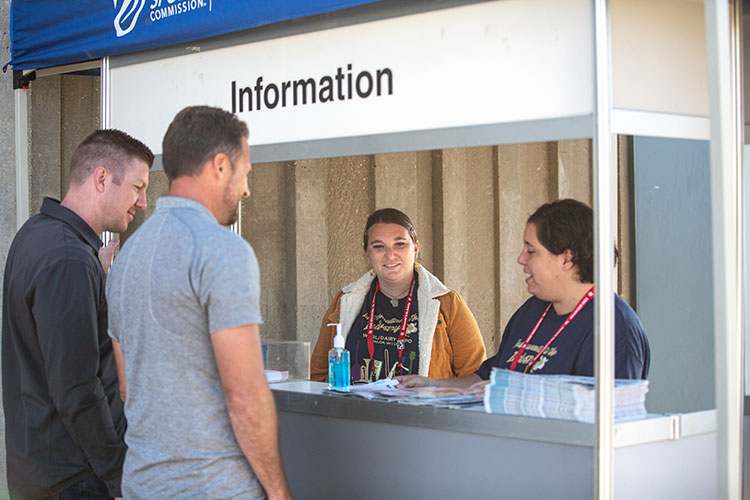The author is an associate editor for Hoard’s Dairyman.

World Dairy Expo is a jam-packed week, but this year, it will look a little different as the global dairy industry’s meeting place operates with a new schedule intended to be more efficient for exhibitors, attendees, and partners.
Up until this year, youth events on Monday led up to the official opening of the show on Tuesday, which ran through the Supreme Ceremony on Saturday. Beginning this year, though, the shift was made to hold events from Sunday through Friday. “It’s a six-day event with a five-day cattle show and four-day trade show,” summarized Expo General Manager Laura Herschleb.
Youth judging, fitting, and showmanship contests will still start the week, with those contests now taking place on Sunday. Cattle shows begin on Monday and conclude with the naming of Supreme Champion on Friday afternoon. The trade show will be open and educational sessions held Tuesday through Friday. For a full schedule of this year’s events, turn to page 436.
Time for change
Interest in tweaking the event’s schedule stemmed from multiple areas and had been gaining momentum for some time as stakeholders looked at how to most efficiently use the time, shared Dairy Cattle Show Manager Ann Marie Magnochi.
One consideration for change was making the event more of a “week-long” occasion while also formally including the junior activities in the Expo dates. Designating the youth contest day as the first official day of Expo boosts attention to those programs that bring so many young dairy enthusiasts to Madison.
There was also the need to modernize the length of the trade show. Most other commercial exhibitor events are typically two or three days, said Herschleb. Moving to a four-day trade show instead of a five-day show that fell over the weekend put Expo more in line with the industry standard.
Balancing the needs of all of the stakeholders and participants of Expo, particularly the trade show and cattle show exhibitors, was key to any changes that would be made to the event’s long-standing schedule.
“We wanted to accommodate those trade show companies but also not take away from our dairy cattle exhibitors who need the amount of time that they have to get everybody through the ring effectively,” said Magnochi.
Making it happen
Putting the wheels in motion to make the change consisted of exploring options and getting feedback from stakeholders. To meet the needs of these major parts of the event, the initial committees consisted of people who understood both the commercial and cattle shows.
Shortening the trade show by one day and shifting educational sessions were relatively logical changes to make; organizing the cattle shows and other events that take place on the colored shavings was more of a jigsaw puzzle. However, there was already some discussion on what could be done to make the showring more effective and efficient, so a change to the timing of the shows worked into that conversation.
Magnochi and the Dairy Cattle Exhibitor Committee used historical data on size and timing of each breed’s shows to place them on the new schedule. “The main thing we wanted to focus on was giving the breed shows the space they need in the showring,” she explained.
That was especially true for Jerseys and Brown Swiss, two fast-growing shows. Those shows, as well as Holsteins and Red and Whites, essentially kept their same position on the show schedule, simply moving up one day with the rest of the event.
“We took those big breeds and said, ‘This is where we know they fit; let’s just put them there and work around them,’” Magnochi continued. The Junior Holstein Show also remained on the first day of the show — now Monday — to connect with the youth events on Sunday.
Additionally, the committee looked at maximizing showring usage by rotating breed shows. With feedback from exhibitors as well as past judges, they adopted a schedule that has the Ayrshire, Guernsey, and Milking Shorthorn shows on a three-year rotation. This year, the entire Milking Shorthorn show will be on Monday, all Guernseys will show on Tuesday, and Ayrshires will be split between heifers Wednesday afternoon and cows Thursday morning. In future years, these breeds will rotate between these show days and times.
Another change to use the showring more effectively was introduced last year when the Junior and Open Show Supreme Ceremonies were combined into one event to work better for animals, exhibitors, and visitors. Now, the Junior and Grand Champion of both the Junior and Open Show for each breed come into the ring for the same event and are recognized. Then, the four Supreme Champions are named sequentially.
In addition to the timing factor, bringing in all four champions for the same ceremony felt more impactful. “Before, it felt like Supreme had two halves, or like it was a play with an intermission,” Magnochi shared. “It just didn’t have the excitement and the grandeur that we want to convey with Supreme, so that was why we switched last year.”
Volunteer led
As with any change, there will be learning curves as the schedule has its first road test, but Expo’s leadership and volunteers are confident it will enhance the experience for exhibitors and visitors. While commercial exhibitors will enjoy a more standard trade show, Magnochi says the cattle show changes will help every animal and exhibitor have the same opportunity in the ring.
Herschleb recognized that Expo’s volunteer committee members are critical in making these decisions and bringing experience to the table to further improve the event.
“Those are people with strings; those are people with the trade show booths. They’re able to share not only their firsthand experience but that of their neighbors and additional feedback they hear,” she said.










